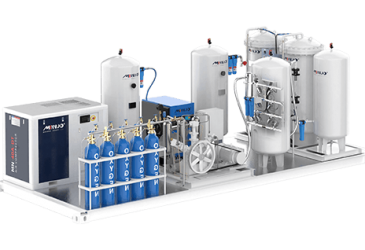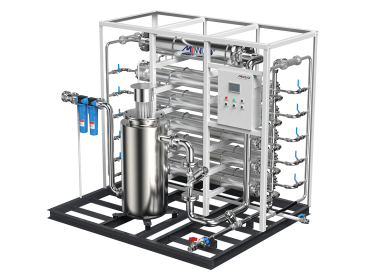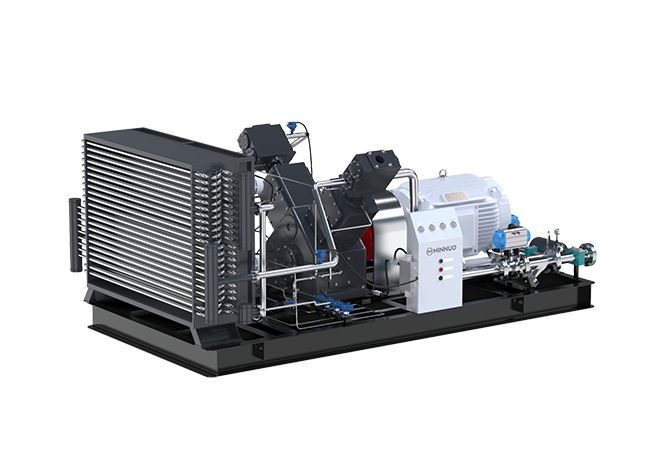In modern industrial production, nitrogen is an essential gas, valued for its unique chemical properties and wide-ranging applications. As the key equipment for nitrogen production, the purity of nitrogen generated by nitrogen generators significantly impacts the production quality and efficiency across industries. Due to varying production processes and product characteristics, different industries have distinct requirements for nitrogen purity. Understanding these variations is crucial for selecting suitable nitrogen generator equipment.
Nitrogen purity requirements for nitrogen generators vary by industry and application. The electronics industry typically requires ≥99.9% or 99.99% purity, or ultra-high purity (≥99.999%) through purification systems. Metallurgy and metal processing industries achieve ≥99.999% purity, while food and pharmaceutical sectors need ≥99.5% or 99.9%. Chemical and new materials industries generally require ≥99% purity, with applications also extending to coal and petroleum industries.

Electronics Industry (≥99.9%, 99.99%, or ≥99.999% with purification systems)
In the electronics industry, nitrogen purity requirements are particularly stringent.
Semiconductor Manufacturing
Wafer Manufacturing: Key processes like epitaxy, diffusion, oxidation, and ion implantation demand nitrogen purity as high as 99.9999% or even higher. In these high-temperature, high-energy environments, ultra-high-purity nitrogen acts as a shield, preventing wafer oxidation and ensuring device stability and high yield rates. For example, during ion implantation, even trace impurities in nitrogen can cause ions to deviate, severely impacting chip performance. Similarly, the production of electronic-grade polysilicon relies on high-purity nitrogen to prevent oxidation and contamination during production.
Electronics Packaging: Packaging processes for electronic components typically require nitrogen purity above 99.99%. High-purity nitrogen serves as a protective gas, preventing oxidation of materials at high temperatures and enhancing packaging reliability. For instance, in ball grid array (BGA) and chip-scale packaging (CSP), nitrogen creates an oxygen-free environment, ensuring packaging quality.
LCD and OLED Manufacturing
In the production of LCD and OLED panels, nitrogen purity typically needs to be ≥99.999%. During the thin-film transistor (TFT) manufacturing process, nitrogen prevents oxidation and contamination, ensuring stable performance. In OLED evaporation processes, ultra-high-purity nitrogen is essential for maintaining the quality of organic materials and achieving effective deposition.
Applications of nitrogen in the electronics industry include packaging, sintering, annealing, reduction, and storage. It is used in wave soldering, reflow soldering, quartz, piezoelectric ceramics, electronic ceramics, electronic copper strips, batteries, and alloy materials. Depending on the application, purity requirements vary, generally not falling below 99.9%. In some cases, 99.99% purity is used, and for the highest demands, nitrogen purified to >99.9995% with a dew point below -65°C is utilized.
Metallurgy and Metal Processing Industry (≥99.999%)
Steel Metallurgy
Steelmaking Process: In conventional steelmaking processes such as converter steelmaking, nitrogen is used for stirring molten steel, preventing oxidation, and protecting furnace linings, requiring purity levels of ≥99.5%. During continuous casting, high-purity nitrogen prevents secondary oxidation of molten steel, enhancing slab quality. For special and alloy steel production, nitrogen purity often exceeds 99.9%. For instance, in stainless steel production, high-purity nitrogen prevents oxidation of chromium and other alloy elements, ensuring corrosion resistance.
Metal Heat Treatment: Nitrogen is used as a protective gas during quenching, tempering, and annealing processes, with purity levels generally exceeding 99.9%. In vacuum heat treatment, high-purity nitrogen creates an inert atmosphere, protecting metal parts from oxidation at high temperatures and aiding cooling.
Non-ferrous Metallurgy
In the smelting and processing of non-ferrous metals like aluminum, copper, and magnesium, nitrogen prevents oxidation and removes hydrogen. For aluminum smelting, nitrogen purity should be ≥99.5%; for copper and magnesium, it should exceed 99%. For example, in aluminum electrolytic processes, high-purity nitrogen prevents anode oxidation and improves current efficiency. During continuous casting and rolling of copper, nitrogen protects the surface of copper billets, preventing oxidation and contamination.
Applications include annealing, sintering, nitriding, furnace cleaning, and purging, commonly found in metal heat treatment, powder metallurgy, magnetic materials, copper processing, metal wire mesh production, galvanizing lines, semiconductors, and powder reduction. Nitrogen purity often exceeds 99.9%, and, when combined with purification systems, can reach >99.9995% with a dew point below -65°C.
Food and Pharmaceutical Industry (≥99.5% or 99.9%)
Food Industry
Food Packaging: High-purity nitrogen removes oxygen from packaging, preventing oxidation and spoilage, thereby extending shelf life. Nitrogen purity is generally ≥99.5%. For instance, in the packaging of chips and nuts, high-purity nitrogen preserves freshness and texture.
Food Preservation: For fresh produce like fruits and vegetables, high-purity nitrogen reduces oxygen levels, slowing respiration and aging. Purity levels are ≥99%. Modified atmosphere packaging technology effectively extends the shelf life of fresh produce by adjusting the proportions of nitrogen, oxygen, and carbon dioxide.
Pharmaceutical Industry
Pharmaceutical Packaging: During packaging, nitrogen removes oxygen and moisture, preventing oxidation, dampness, and spoilage. Purity levels are ≥99.9%. For instance, in the packaging of injections and tablets, high-purity nitrogen enhances stability and shelf life.
Pharmaceutical Processes: Nitrogen is used to protect reactors, transport materials, and dry pharmaceuticals. For oxygen-sensitive drugs like antibiotics and biopharmaceuticals, nitrogen purity levels are often ≥99.99%. High-purity nitrogen protects bioactive substances during cell culture from oxidation.
Processed nitrogen meets the industry’s requirements for sterility, dust removal, and moisture control. Applications include food packaging, preservation, pharmaceutical packaging, displacement gases, and transport atmospheres, typically achieving ≥99.5% or 99.9% purity through pressure swing adsorption technology.
Chemical and New Materials Industry (≥99%)
Chemical Industry
Chemical Synthesis: Nitrogen serves as a protective gas or reaction medium in chemical synthesis processes, requiring purity levels of ≥99%. For example, in the production of ammonia or methanol, nitrogen is used as a raw material or protective gas. In the production of polyethylene and polypropylene, high-purity nitrogen prevents oxidation and degradation during polymerization.
Chemical Storage and Transport: During the storage and transport of chemical products, nitrogen prevents oxidation, explosions, and volatilization, with purity requirements generally ≥99%. For instance, nitrogen in oil storage tanks prevents oxidation and volatilization, ensuring safety. In chemical pipeline transport, nitrogen is used for purging and displacement, ensuring uncontaminated media flow.
New Materials Industry
Carbon Fiber Manufacturing: During carbonization and graphitization of carbon fiber, nitrogen acts as a protective gas, requiring purity levels of ≥99.99%. High-purity nitrogen prevents oxidation at high temperatures, ensuring quality and performance.
Semiconductor Material Manufacturing: In the production of semiconductor materials like silicon wafers and gallium arsenide, high-purity nitrogen is used for cleaning, drying, and protection. Purity requirements often exceed 99.9999%, ensuring material quality and purity.
Applications in the chemical and new materials sectors include raw material gases, pipeline purging, atmosphere displacement, protective atmospheres, and product transport, covering industries such as chemicals, spandex, rubber, plastics, tires, polyurethane, biotechnology, and intermediates, with nitrogen purity not falling below 99%.
Other Industries
Coal Industry
In coal mining, nitrogen gas is utilized for fire suppression and to prevent gas explosions. For these applications, nitrogen purity must exceed 97%. High-purity nitrogen can reduce oxygen levels in coal seams, preventing spontaneous combustion and gas explosions. For example, during underground coal mine firefighting, injecting high-purity nitrogen into fire zones rapidly reduces oxygen content, effectively extinguishing the fire.
Petroleum Industry
Oil Extraction:In oil extraction, nitrogen gas is used for well fracturing and enhanced oil recovery. For well fracturing, nitrogen purity must exceed 95%. High-purity nitrogen increases well output and improves oil recovery rates. For instance, in hydraulic fracturing, adding nitrogen reduces the density of the fracturing fluid, enhancing the fracturing effect.
Oil Storage and Transportation:During oil storage and transportation, nitrogen gas is employed to prevent oxidation, explosions, and evaporation of oil products. Nitrogen purity must exceed 99%. For example, injecting nitrogen into oil storage tanks prevents oxidation and evaporation, enhancing storage safety. In oil pipeline transportation, nitrogen is used for purging and displacement, ensuring the medium inside the pipeline remains uncontaminated.
Automotive Tire Industry
In the production of automotive tires, nitrogen gas is used for tire inflation. Compared to regular air, high-purity nitrogen improves tire stability and wear resistance, reduces rolling resistance, and saves fuel. Nitrogen purity must exceed 95%. For example, in the production of high-performance tires, inflating them with high-purity nitrogen enhances their performance and service life.

Conclusion
When selecting a nitrogen generator, industries should consider their specific production processes and application scenarios to choose the appropriate model and nitrogen purity specifications.MINNUO nitrogen generators leverage advanced “Pressure Swing Adsorption and Membrane Separation Coupling” technology, enabling precise nitrogen purity control and reducing energy consumption by 20% compared to industry counterparts, significantly lowering operational costs.
MINNUO is committed to offering tailored solutions based on the unique requirements of various industries, ensuring nitrogen purity meets stringent demands. Feel free to reach out for consultation!






 sales2:+86 17506119168
sales2:+86 17506119168

